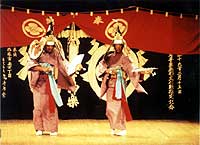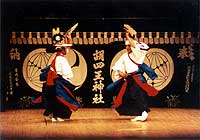
| Pseudonym reading | Yamagura of Hanamaki |
|---|---|
| Specified type | Prefecture designation |
| Type | Intangible folk cultural property |
| Designated date | May 11, 2001 |
| Specified details | |
| quantity | |
| location | Hanamaki City Kachikachikan Kannon Hanamaki City Koda Hanamaki City Yazawa |
| owner | |
| Holding group | Enmanji Kagura Preservation Society Kouda Kagura Preservation Society Hu Four Kings Kagura Preservation Society |
| Management organization | |
| home page | Hanamaki's cultural property, Enmanji Kagura Kouda Kagura, a cultural asset of Hanamaki |
Overview
There are Yamabushi Kagura, Daikori Kagura and Daikagura in Kagura in Hanamaki City.
Among them, Yamabushi Kagura is popular, and there are Takeda Kagura of Hayaike Mine Kagura, a compliment Kagura of Hayaike Mine Kagura, and another Manganji Kagura of another system.
Yamabushi Kagura is one of the gyoza kagura that was once handed down by Shugensanbushi, and is located in the south of Aomori prefecture to the Sankodo-Kabura family in the northern part of Iwate prefecture, the Kuromori kagura family in the central northern part of Iwate The Hayaike Mine Kagura lineage of the region is located at the top of it is the Hayaike Mine Kagura line which has been handed down by the masters who use the Hayaike Mine mountain as a sacred place.
Both Koda Kagura and Hu four king Kagura of Hanamaki City are Hayake Mine Kagura's Takeda Kagura, but there are some differences in performance and art form because the exchange was discontinued early.
Each Kagura has a large number of performances, is excellent in arts and crafts, and inherits ritual elements such as the New Year's door hanging (spring prayer and fire-bush prayer) characteristic of Yamabushi Kagura.
There are also many disciple kagura, and around Hanamaki, they are called Koda and Hu 4o.
In addition, Enman-ji Temple Kagura is a Kagura representing Yamabushi Kagura of Hanamaki City, and has been designated as a prefecture designated cultural asset in 1949.
This Enman-ji Temple Kagura is said to be a complimented Kagura-kei system of Hayaike Mine Kagura in the oral tradition, but there are also differences in performances and performances, and the dance has a feature with elements similar to the Kufuto System in the prefecture north .
As described above, “Yamashu Kasakura of Hanamaki” represented by Enman-ji Temple Kagura, Koda Kagura and Hu 4 Wang Kagura both clearly express regional features while drawing the genealogy of Hayaike Mine Kagura.
(Intangible Folk Cultural Property Designation Criteria 2- (3))
image

